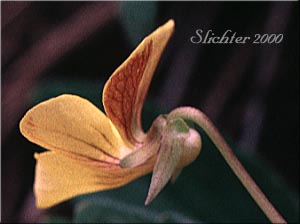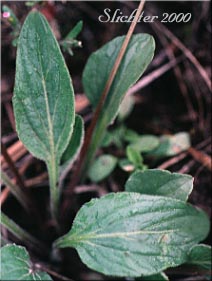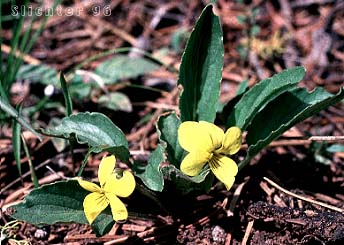

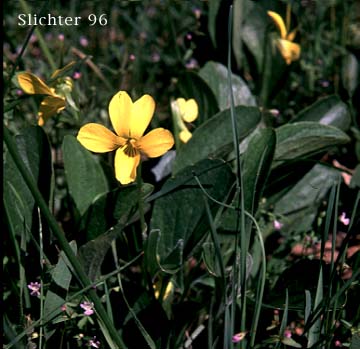 Photo at right of prairie violet (var. praemorsa) from the Columbia Hills, north of the Dallesport, WA........April, 1989.
Photo at right of prairie violet (var. praemorsa) from the Columbia Hills, north of the Dallesport, WA........April, 1989.
Yellow prairie violet is an attractive dryland violet with clumps of green leaves and several bright yellow flowers found on stems (to 15 cm high) that are about equal in height to the leaves. The leaf blades range from smooth to copiously covered with minute hairs, the blades narrowly elliptic lanceolate to ovate or lanceolate, depending on the variety. The margins are entire or wavy-margined, or occasionally lightly toothed. The blades range from 2-10 cm in length, while the long thin petioles range from 3-15 cm long.
The flowers are bright yellow, from 5-15 mm long with a short spur. The upper 2 petals may be clear yellow on the back (as in variety bakeri) or may have brownish backs (as in the other varieties). The lower 3 petals are penciled with brownish-purple lines in the throat.
Yellow Prairie Violet, Baker's Violet: Viola bakeri (formerly Viola nuttallii var. bakeri) - Upper petals not rusty brown-colored on their backs. Flowers 5-12 mm long. Leaf blades 2-5 cm long. Capsules glabrous. Generally limited to the Cascade Mts from Mt. Adams south to California.
Upland Yellow Violet, Wavyleaf Violet: Viola praemorsa ssp. linguifolia (formerly Viola nuttalli var. major) - Backs of upper petals generally rusty brown in color. Flowers 8-15 mm long. Leaf blades 5-10 cm long, glabrous to moderately hairy, and not noticeably fleshy. Blades elliptical in outline. Capsules mostly hairy. Generally found east of the Cascade Mts., extending westward into the Siskiyou Mts. in southwest Oregon.
Upland Yellow Violet, Canary Violet: Viola praemorsa ssp. praemorsa (formerly Viola nuttallii var. praemorsa) - Backs of upper petals generally rusty brown in color. Flowers 8-15 mm long. Leaf blades 5-10 cm long, generally strongly hairy, and thick and fleshy. Blades ovate-lanceolate in shape, the base not truncate or subcordate. Capsules mostly hairy. More frequently found west of the Cascades, but occasionally found east of the Cascades.
Valley Yellow Violet: Viola vallicola (formerly Viola nuttallii var. vallicola) - Backs of upper petals generally rusty brown in color. Flowers 8-15 mm long. Leaf blades less than 5 cm long, glabrous to sparsely haired, ovate to ovate-lanceolate in outline with truncate or subcordate base. Capsules glabrous. Generally found east of the Cascade Mts.
Yellow prairie violet may be found in open grasslands, among sagebrush, or in open ponderosa pine or oak forests.
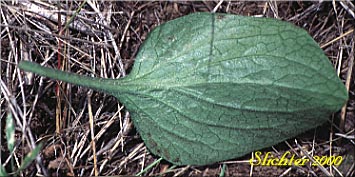

Yellow prairie violet is found east of the coastal mountains from British Columbia south to California and east to the central United States.
